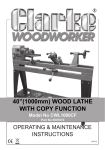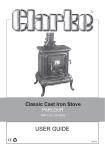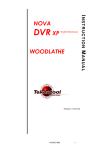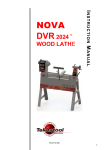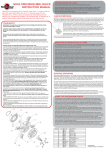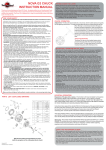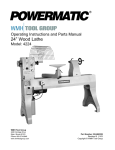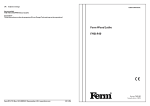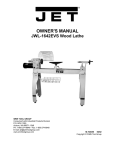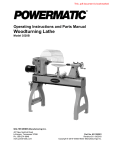Download Clarke CWL325V Instruction manual
Transcript
VARIABLE SPEED LATHE Model No CWL325V Part No 6501660 OPERATING & MAINTENANCE INSTRUCTIONS GC0710 INTRODUCTION Thank you for purchasing this CLARKE Wood Lathe. Before attempting to operate the machine, it is essential that you read this manual thoroughly and carefully follow all instructions given. In doing so you will ensure the safety of yourself and that of others around you, and you can also look forward to the product giving you long and satisfactory service. GUARANTEE This CLARKE product is guaranteed against faulty manufacture for a period of 12 months from the date of purchase. Please keep your receipt as proof of purchase. This guarantee is invalid if the product is found to have been abused or tampered with in any way, or not used for the purpose for which it was intended. Faulty goods should be returned to their place of purchase, no product can be returned to us without prior permission. This guarantee does not effect your statutory rights. ENVIRONMENTAL PROTECTION Do not dispose of this product with general household waste. All tools, accessories and packaging should be sorted, taken to a recycling centre and disposed of according to the laws governing Waste Electrical and Electronic Equipment. SAFETY SYMBOLS The following safety symbols are displayed on the machine. Wear dust protection Wear eye protection Read instructions before use 2 CONTENTS Introduction ............................................................................................ 2 Guarantee .............................................................................................. 2 Environmental Protection ...................................................................... 2 Safety Symbols ....................................................................................... 2 General Safety Rules ............................................................................. 3 Electrical Connections .......................................................................... 6 Main Components ................................................................................. 7 Unpacking & Assembly ......................................................................... 8 Operation ............................................................................................. 10 Maintenance ........................................................................................ 10 Technical Specification ....................................................................... 11 Troubleshooting .................................................................................... 12 Parts List and Diagrams ....................................................................... 13 Declaration of Conformity .................................................................. 15 GENERAL SAFETY RULES Important Note: Although the operation manual contains extensive instruction on the safe working with power tools, every power tool involves some risk which cannot be completely excluded. Power tools must therefore always be operated with caution. WORK AREA SAFETY 1. Keep work area clean and well lit. Cluttered or dark areas invite accidents. 2. Do not operate power tools in explosive atmospheres, such as In the presence of flammable liquids, gases or dust. Power tools create sparks which may Ignite the dust or fumes. 3. Keep children and bystanders away while operating a power tool. Distractions can cause you to lose control. ELECTRICAL SAFETY 1. Power tool plugs must match the outlet. Never modify the plug in any way. Do not use any adapter plugs with earthed (grounded) power tools. Unmodified plugs and matching outlets will reduce risk of electric shock. 3 2. Avoid body contact with earthed or grounded surfaces, such as pipes, radiators, ranges and refrigerators. There is an increased risk of electric shock if your body is earthed or grounded. 3. Do not expose power tools to rain or wet conditions. Water entering a power tool will increase the risk of electric shock. 4. Do not abuse the cable. Never use the cable for pulling or unplugging the power tool. Keep cable away from heat, oil, sharp edges or moving parts. Damaged or entangled cables increase the risk of electric shock. 5. If operating a power tool in a damp location is unavoidable, use a residual current device (RCD) protected supply. Use of an RCD reduces the risk of electric shock. PERSONAL SAFETY 1. Stay alert, watch what you are doing and use common sense when operating a power tool. Do not use a power tool while you are tired or under the influence of drugs, alcohol or medication. A moment of inattention while operating power tools may result in serious personal injury. 2. Use personal protective equipment. Always wear eye protection. Protective equipment such as dust mask, non-skid safety shoes, or hearing protection used for appropriate conditions will reduce personal injuries. 3. Prevent unintentional starting. Ensure the switch is in the off-position before connecting to power source. 4. Remove any adjusting key or wrench before turning the power tool on. A wrench or a key left attached to a rotating part of the machine may result in personal injury. 5. Do not overreach. Keep proper footing and balance at all times. This enables better control of the power tool in unexpected situations. 6. Dress properly. Do not wear loose clothing or jewellery. Keep your hair, clothing and gloves away from moving parts. Loose clothes, jewellery or long hair can be caught in moving parts. 7. Use of dust collection can reduce dust-related hazards. POWER TOOL USE AND CARE 1. Do not force the machine. The machine will do the job better and safer at the rate for which it was designed. 2. Do not use the power tool if the switch does not turn it on and off. Any power tool that cannot be controlled with the switch Is dangerous and must be repaired. 3. Store power tools out of the reach of children and do not allow persons unfamiliar with the power tool or these instructions to operate the tool. Power tools are dangerous in the hands of untrained users. 4 4. Maintain power tools. Check for misalignment or binding of moving parts, breakage of parts and any other condition that may affect the tool’s operation. If damaged, have the tool repaired before use. Many accidents are caused by poorly maintained power tools. 5. Keep cutting tools sharp and clean. Properly maintained cutting tools with sharp cutting edges are less likely to bind and are easier to control. 6. Use the power tool, accessories and tool bits etc in accordance with these instructions, taking into account the working conditions and the work to be performed. Use of the power tool for operations different from those intended could result in a hazardous situation. SERVICE 1. Have your power tool serviced by a qualified repair person using only identical replacement parts. This will ensure that the safety of the power tool is maintained. ADDITIONAL SAFETY RULES FOR WOODLATHES 1. IMPORTANT: You should familiarise yourself with woodlathes and turning techniques before using the machine. If there is any doubt whatsoever you should consult a qualified person. 2. ALWAYS store chisels safety when you have finished with the machine. 3. CAUTION: This machine is designed for use with woodturning chisels only. 4. NEVER attempt to turn a workpiece unless a suitable support is used. 5. ALWAYS stop the lathe before removing workpieces, work supports or swarf from the table. 6. ALWAYS be sure that the workpiece is securely locked in position. 7. ALWAYS keep hands and fingers away from the moving workpiece. WARNING: DUST GENERATED FROM CERTAIN MATERIALS CAN BE HAZARDOUS TO YOUR HEALTH. ALWAYS OPERATE THE LATHE IN A WELL VENTILATED AREA. USE A DUST COLLECTION SYSTEM WHENEVER POSSIBLE. 5 ELECTRICAL CONNECTIONS WARNING! Read these electrical safety instructions thoroughly before connecting the product to the mains supply. Before switching the product on, make sure that the voltage of your electricity supply is the same as that indicated on the rating plate. This product is designed to operate on 230VAC 50Hz. Connecting it to any other power source may cause damage. This product may be fitted with a non-rewireable plug. If it is necessary to change the fuse in the plug, the fuse cover must be refitted. If the fuse cover becomes lost or damaged, the plug must not be used until a suitable replacement is obtained. If the plug has to be changed because it is not suitable for your socket, or due to damage, it should be cut off and a replacement fitted, following the wiring instructions shown below. The old plug must be disposed of safely, as insertion into a mains socket could cause an electrical hazard. WARNING! The wires in the power cable of this product are coloured in accordance with the following code: Blue = Neutral Brown = Live Yellow & Green = Earth If the colours of the wires in the power cable of this product do not correspond with the terminal markings of your plug, proceed as follows. • The wire which is coloured Blue must be connected to the terminal which is marked N or coloured Black. • The wire which is coloured Brown must be connected to the terminal which is marked L or coloured Red. • The wire which is coloured Yellow & Green must be connected to the terminal which is marked E or coloured Green. Plug must be BS1363/A approved Earth (Green & Yellow Always fit a 13 Amp fuse. Neutral (Blue) Live (Brown) Ensure that the outer sheath of the cable is firmly held by the clamp We strongly recommend that this machine is connected to the mains supply via a Residual Current Device (RCD) If in doubt, consult a qualified electrician. DO NOT attempt repairs yourself. 6 MAIN COMPONENTS Faceplate G B Headstock Drive Centre H Speed Control C Tool Rest I Thermal Overload Reset Button D Tail-stock Spindle J Tool Rest Support E Tail-stock Body K Tool Rest Locking Lever F Tail-stock Advancing Handle A A G H I ON/OFF Switch B J C D E F K ACCESSORIES The following range of accessories are also available from your Clarke dealer: 8-Piece Chisel Set Part No: 6500649 4-Jaw Independent Lathe Chuck Part No: 6500645 1/2” Cap. 1MT Tailstock Chuck Part No: 6500643 2” Mini Chuck Set Part No: 6501662 7 UNPACKING When unpacking, check for damage or omissions etc. Any found should be reported to your CLARKE dealer where the appliance was originally purchased. Do not discard the packaging until the machine is assembled. The following items are supplied loose: 1 x Lathe 1 x Tool Rest Support Locking Lever 1 x Tool Rest, 110mm 1 x Toolrest Locking Lever 1 x Tool Rest, 170mm 1 x Fixings Pack 1 x Face Plate, 145mm dia 1 x Drift Rod 1 x Headstock Centre Spur 1 x Open Spanner 1 x Tailstock Centre Spindle 2 x Allen Keys (3mm & 5mm) 1 x Tailstock Locking Lever 1 x Instruction Manual (this document) 1 x Tool Spindle Locking Lever 8 ASSEMBLY 1. Screw the tailstock spindle into the tailstock as shown in Fig 1. Note: A left-hand thread is used for this. 2. Attach the tailstock spindle locking lever and the tailstock locking lever in their postions using the coil spring and machine screw provided. 3. Attach the tool rest locking lever and the support locking lever in their postions using the coil spring and machine screw provided for each as shown in Fig 2. Fig 1 4. Install the tool rest of your choice into the hole in the tool rest support. Position the working edge of the rest parallel with the centre axis of the lathe and secure with the tool rest locking lever. The position of the support will be adjusted to suit the workpiece. Fig 2 5. Screw the faceplate onto the headstock spindle while inserting the drift rod into the hole in the spindle to prevent it from turning. Tighten the faceplate using the open spanner provided as shown in Fig 3. 6. If the work is to be held in position between the headstock and tailstock, insert the headstock spur into the tapered hole in the headstock spindle. Provided the faceplate is fitted, the spur can be removed later by driving it away from the headstock by unscrewing the faceplate with the spanner in the usual way. 9 Fig 3 OPERATION 1. Press the green push-button to start the lathe and adjsut the speed using the speed control knob. 2. Always use the lowest speed when starting a new workpiece. 3. Always rotate the workpiece by hand before turning on the motor and check it does not strike the tool/tool rest. 4. Ensure tool rest and tailstock are securely locked in position before starting work. 5. Always position the tool-rest just above the centre-line of the lathe. 6. Avoid turning timber which has splits or substantial knots or voids and take special care if these are discovered. 7. When turning, always roughly turn the work to a round form at slow speed. 8. Take care that the turning tools do not bite suddenly into the workpiece. MAINTENANCE For maximum performance, it is essential that the machine is properly maintained. Always inspect before use. Any damage should be repaired and faults rectified. The machine requires very little maintenance other than the following guidelines. IMPORTANT - Disconnect from mains power before cleaning. 1. Vacuum clean any dust or shavings that accumulate in or on the motor. 2. Check all cables periodically and ensure that they are in good condition and not cracked. 3. Check the tightness of the mounting bolts. 4. Check the drive belt for wear and replace if it is frayed or otherwise damaged. 5. Periodically lubricate the tail-stock, screw threads with engine oil such as SAE20 or SAE30 grade if they become stiff to use. 6. Lightly lubricate the tail-stock and tool-post locking handles with oil if they become difficult to use. • The ball bearings in the headstock and tail-stock spindles are greased and permanently sealed at the factory and require no further lubrication. REPLACING THE BELT Note: Part numbers refer to the Parts Diagram on page 13. 1. Undo the three screws (28) and remove the end cover (27). 10 2. Using the allen key supplied, loosen the bolts (39) to enable the motor to move and the drive belt to go slack. 3. Dismount the drive belt from the motor pulley (34) and then lift it off the drive pulley (31) towards you. Use the allen key to help you as shown in Fig 4. The belt can now be removed from the headstock frame. Fig 4 4. Replacement is a reversal of the removal procedure. Tension the belt by hinging the motor downwards prior to tightening the bolts (39). Please refer to TROUBLESHOOTING on page 12. If you are unable to rectify any faults, please contact your local dealer or Clarke International Service Department on 0208 988 7400 for assistance. TECHNICAL SPECIFICATION Feature Specification Weight Dimensions (L x W x H) 21 kg 732 x 222 x 300mm (tailstock & toolrest ext) Speed 890 - 3190 rpm (variable) Distance between centres 325 mm Turning Capacity 200 mm Spindle Thread 3/4" x 16TPI (UNF) IP Rating IP20 Motor voltage/frequency 230V / 50 Hz Rated Input Wattage 250 W Sound Pressure Level No load 75.3/ Loaded 82.5LpA dB(A) Measured Sound Power Level No load 84.3 / Loaded 91.8LwA dB(A) Please note that the details and specifications contained herein, are correct at the time of going to print. However, CLARKE International reserve the right to change specifications at any time without prior notice. 11 TROUBLESHOOTING PROBLEM Motor will not run. CAUSES SUGGESTIONS 1. Defective/broken switch. Send to your Clarke dealer for repair. 2. Damaged power cable. Send to your Clarke dealer for replacement. 3. Open circuit, loose connections or burned out motor. Replace fuse or re-set circuit breaker. Turn off other machines on the same circuit. 4. Blown fuse or circuit breaker. Check the power supply for correct voltage. Use another circuit or have a qualified electrician upgrade the power supply. Send to your Clarke dealer for repair. 5. Low voltage. Motor will not start 1. Short circuit in motor or and fuses or circuit power cable. breaker trip out. 2. Incorrect fuses or circuit breakers. Motor fails to 1. Overloaded circuit. reach full power. 2. Unsuitable extension cable. Motor stalls. 1. Short circuit in motor. Noisy operation Replace with correct fuse or circuit breaker for the circuit. Turn off other machines & retry. Replace with correct size extension cable. Send to your Clarke dealer for repair. 2. Incorrect fuses or circuit breakers. Replace with correct fuse or circuit breaker for the circuit. 3. Overloaded circuit. Turn off other machines & retry. 4. Low voltage. Check the power supply for correct voltage. Use another circuit or have a qualified electrician upgrade the service. Adjust belt tension. See "Replacing the Belt" section on page 10. 1. Incorrect belt tension. 2. Dry spindle. Lubricate the spindle. 3. Loose drive pulley. T ighten the retaining set-screw on the pulley. 12 PARTS DIAGRAM 13 PARTS LIST No Description No Description 1 Bed 26 Headstock Spindle Nut 2 Retaining End Plate 27 End Cover 3 Self-tapping Screw 28 Screw 4 Grub Screw 29 Eccentric Shaft 5 Handwheel 30 Setscrew 6 Tailstock Frame 31 Drive Pulley 7 Small Locking Lever 32 Drive Belt 8 Threaded Boss 33 Tool Rest Base 9 Sleeve 34 Motor Pulley 10 Eccentric Shaft 35 Power Cable 11 Tailstock Spindle 36 Speed Controller 12 Circlip 37 Screw 13 Bearing race 38 Tension Bolt 14 Tailstock Spur Centre 39 Socket Head Bolt 15 Headstock Spur Centre 40 Motor Mount Plate 16 Large Locking Lever 41 Motor 17 Faceplate 42 Retaining Disc 18 Headstock Spindle 43 Circlip 19 Bearing Race 44 Retaining Nut 20 Circlip 45 Circuit Breaker 21 Tension Bolt 46 Fuse (10 amp) 22 Tool Rest 47 Fuse Holder 23 Headstock Body 48 Printed Circuit Board 24 Coil Spring 49 Drift Rod 25 Special Bolt When requesting spare parts, please quote the reference QBCWL325V followed by the number (1-49) on the above parts list. 14 DECLARATION OF CONFORMITY 15

















